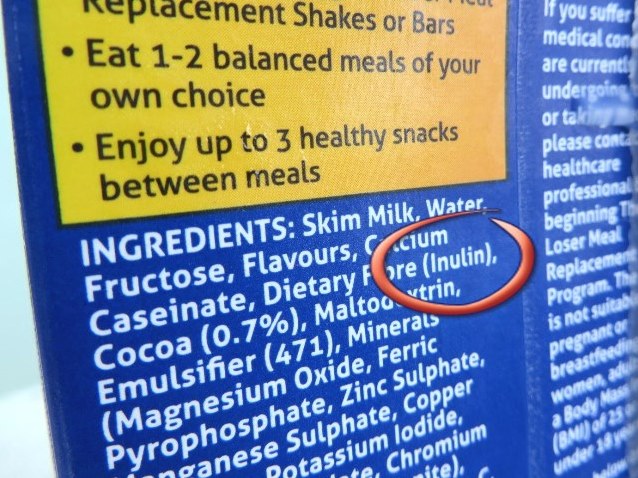- Home
- Blog
- Additives and Labels
- What is inulin?
What is inulin?
Written by Catherine Saxelby
on Wednesday, 11 February 2015.
Tagged: Fibre, Food labels, label

You’ve seen it on the labels of liquid breakfasts, meal replacement shakes, protein drinks, muesli bars and high-fibre yoghurts. You’ve almost certainly already eaten it but what the heck is inulin? Why is it used and where does it come from?
What exactly is inulin?
Inulin is a type of starchy carbohydrate that we can’t digest. In large concentrations, it occurs naturally in chicory root (which is where it’s extracted from) but there are lesser amounts in Jerusalem artichokes, onion, garlic, rye, wheat, asparagus and banana.
It acts as ‘food’ for the ‘friendly’ bacteria that live in our large intestine and it activates their growth allowing them to flourish and multiply, thus creating a healthy intestinal ecosystem. The ‘friendly’ bacteria break the inulin down into beneficial gases such as butyrate in our bowels which sometimes we pass out as ‘wind’.
Why it’s used
Don’t confuse inulin with the hormone insulin that regulates blood glucose. Inulin works as a fibre to boost the soluble fibre in drinks, bars, yoghurts and powders. Thus it adds bulk to your stools, lowers blood cholesterol and reduces the kilojoules your body ‘extracts’ from foods.
It does all this in an ‘invisible’ way as it’s tasteless and dissolves readily without forming a sludgy layer at the bottom, as wheat bran or oat bran would do.
Food manufacturers love it as it gives a creamy, fat-like feeling to diet products without adding any extra fat or kilojoules. Think smooth ‘mouthfeel’!
Where does inulin come from?

On the back of a label, you’ll see inulin listed in the Ingredient List as Dietary Fibre or sometimes as Fructans or Fructo-Oligo-Fructose or FOS – not to be confused with the sugar fructose.
The bottom line
Inulin adds fibre but it’s not a whole food that’s high in fibre like brown rice or lentils. Like other purified fibres such as soy fibre extract and cellulose, it isn’t a fibre you can chew on which is important in satiety (filling power) and health. Think of it as a convenient way to boost the fibre in pre-prepared drinks but don’t let it be your main, or only, source of dietary fibre.
You may also be interested in...
Foodwatch
The Good Stuff
The Boring Stuff
© 2025 Foodwatch Australia. All rights reserved
Website by Joomstore eCommerce





